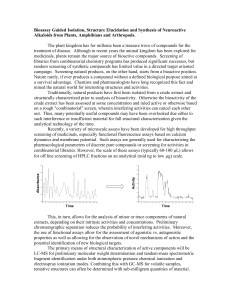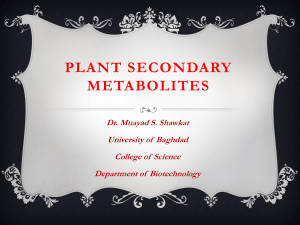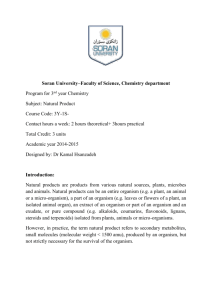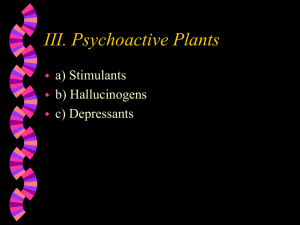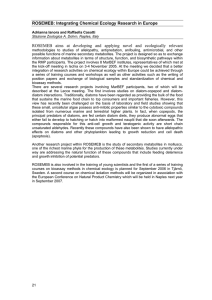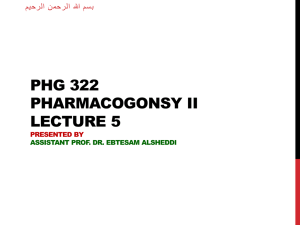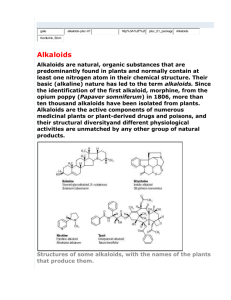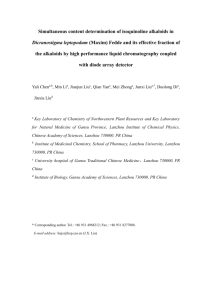Document 14120572
advertisement
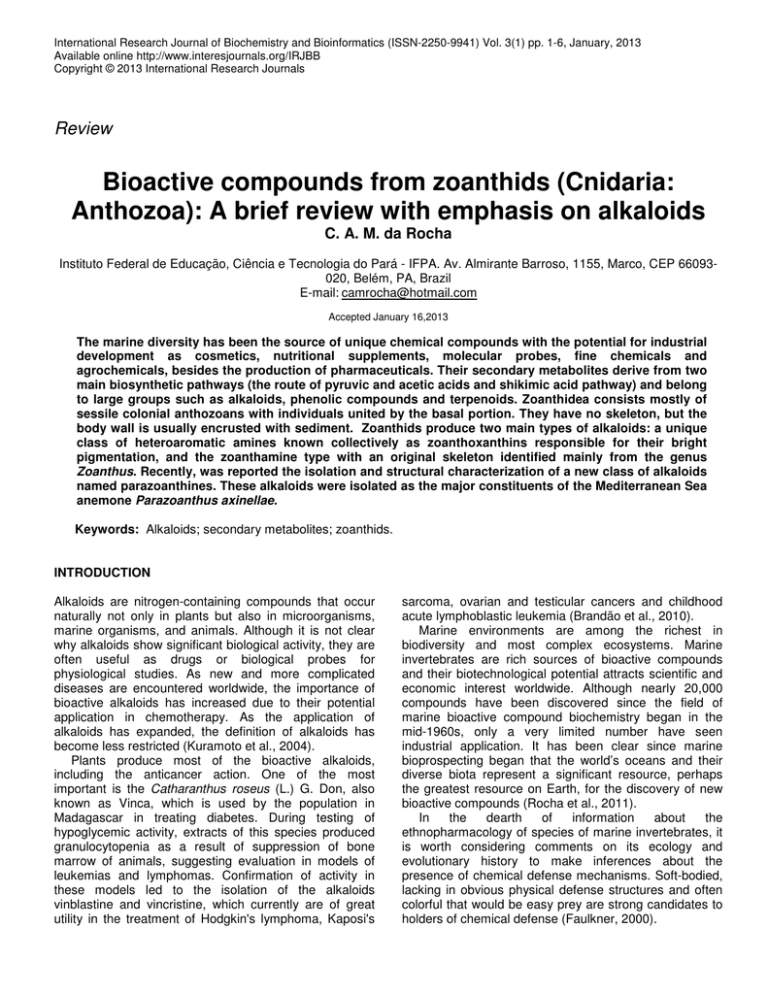
International Research Journal of Biochemistry and Bioinformatics (ISSN-2250-9941) Vol. 3(1) pp. 1-6, January, 2013 Available online http://www.interesjournals.org/IRJBB Copyright © 2013 International Research Journals Review Bioactive compounds from zoanthids (Cnidaria: Anthozoa): A brief review with emphasis on alkaloids C. A. M. da Rocha Instituto Federal de Educação, Ciência e Tecnologia do Pará - IFPA. Av. Almirante Barroso, 1155, Marco, CEP 66093020, Belém, PA, Brazil E-mail: camrocha@hotmail.com Accepted January 16,2013 The marine diversity has been the source of unique chemical compounds with the potential for industrial development as cosmetics, nutritional supplements, molecular probes, fine chemicals and agrochemicals, besides the production of pharmaceuticals. Their secondary metabolites derive from two main biosynthetic pathways (the route of pyruvic and acetic acids and shikimic acid pathway) and belong to large groups such as alkaloids, phenolic compounds and terpenoids. Zoanthidea consists mostly of sessile colonial anthozoans with individuals united by the basal portion. They have no skeleton, but the body wall is usually encrusted with sediment. Zoanthids produce two main types of alkaloids: a unique class of heteroaromatic amines known collectively as zoanthoxanthins responsible for their bright pigmentation, and the zoanthamine type with an original skeleton identified mainly from the genus Zoanthus. Recently, was reported the isolation and structural characterization of a new class of alkaloids named parazoanthines. These alkaloids were isolated as the major constituents of the Mediterranean Sea anemone Parazoanthus axinellae. Keywords: Alkaloids; secondary metabolites; zoanthids. INTRODUCTION Alkaloids are nitrogen-containing compounds that occur naturally not only in plants but also in microorganisms, marine organisms, and animals. Although it is not clear why alkaloids show significant biological activity, they are often useful as drugs or biological probes for physiological studies. As new and more complicated diseases are encountered worldwide, the importance of bioactive alkaloids has increased due to their potential application in chemotherapy. As the application of alkaloids has expanded, the definition of alkaloids has become less restricted (Kuramoto et al., 2004). Plants produce most of the bioactive alkaloids, including the anticancer action. One of the most important is the Catharanthus roseus (L.) G. Don, also known as Vinca, which is used by the population in Madagascar in treating diabetes. During testing of hypoglycemic activity, extracts of this species produced granulocytopenia as a result of suppression of bone marrow of animals, suggesting evaluation in models of leukemias and lymphomas. Confirmation of activity in these models led to the isolation of the alkaloids vinblastine and vincristine, which currently are of great utility in the treatment of Hodgkin's lymphoma, Kaposi's sarcoma, ovarian and testicular cancers and childhood acute lymphoblastic leukemia (Brandão et al., 2010). Marine environments are among the richest in biodiversity and most complex ecosystems. Marine invertebrates are rich sources of bioactive compounds and their biotechnological potential attracts scientific and economic interest worldwide. Although nearly 20,000 compounds have been discovered since the field of marine bioactive compound biochemistry began in the mid-1960s, only a very limited number have seen industrial application. It has been clear since marine bioprospecting began that the world’s oceans and their diverse biota represent a significant resource, perhaps the greatest resource on Earth, for the discovery of new bioactive compounds (Rocha et al., 2011). In the dearth of information about the ethnopharmacology of species of marine invertebrates, it is worth considering comments on its ecology and evolutionary history to make inferences about the presence of chemical defense mechanisms. Soft-bodied, lacking in obvious physical defense structures and often colorful that would be easy prey are strong candidates to holders of chemical defense (Faulkner, 2000). 2 Int. Res. J. Biochem. Bioinform. Figure 1. Major pathways of secondary metabolism and their interconnections Cnidarians, sponges, molluscs, sea squirts and algae make up the group of chemically most prolific marine representatives (Wilke, 2009). Among the cnidarians, the class of anthozoans hitherto been the most studied, observing a reasonable number of biologically active substances, particularly in soft corals and gorgonians (Teixeira, 2009) Cnidaria is a diverse group of marine invertebrates includes over 11,000 species, 7500 of them belonging to the class Anthozoa (Rocha et al., 2011). The order Zoanthidea consists mostly of sessile colonial anthozoans with individuals united by the basal portion. They have no skeleton, but the body wall is usually encrusted with sediment and, usually, harbor zooxanthellae symbionts (Longo, 2002). Antitumor activity has been the major area of interest in the screening of cnidarian compounds, the most promising ones being terpenoids (monoterpenoids, diterpenoids, sesquiterpenoids) (Rocha et al., 2011). Apart from anticancer activity, these compounds have proven to be an abundant source of pharmacologically active agents for the production of therapeutic entities (Glaser and Mayer, 2009) against AIDS, inflammatory conditions and microbial diseases. Besides the production of pharmaceuticals, this marine diversity has been the source of unique chemical compounds with the potential for industrial development as cosmetics, nutritional supplements, molecular probes, fine chemicals and agrochemicals (Kijjoa and Sawangwong, 2004). This review attempted to bring together several recent publications that focus on some of the most promising marine bioactive alkaloids isolated from zoanthids. Printed materials were used, as well as studies obtained from scientific databases on the internet, such as: (1) Scielo (www.scielo.br), (2) BIREME/BVS - Biblioteca Virtual em Saúde [Virtual Health Library] (www.bireme.br), and (3) PubMed (http://www.ncbi.nlm.nih.gov/entrez/query.fcgi). Main groups of secondary metabolites The products of secondary metabolism are substances belonging to a single type of organism, or a small group of genetically related organisms (Mann, 1987). According to Teixeira (2009), these products mediate ecological interactions between organisms and environment and between various organisms of the same species or between different species. Such substances, which allowed the success of the current representatives, have been studied by chemists of natural products and have also been a source of food, fragrances, pigments, insecticides and medicines. Natural products or secondary metabolites derive from two main biosynthetic pathways (the route of pyruvic and acetic acids and shikimic acid pathway) and belong to large groups such as alkaloids, phenolic compounds and terpenoids (Figure 1). The term alkaloid was first proposed by Meissner in 1818 referring to their alkaline properties. In general, the nitrogen atom present in these molecules is from amino acids and the heterocyclic ring formed provides the basis for classification (Bruneton, 1999). The alkaloids are derived from aromatic amino acids (tryptophan, tyrosine), which are derivatives of shikimic acid, as well as aliphatic amino acids (ornithine, lysine). Phenolic compounds are a large and diverse group of molecules, which includes many different families of aromatic secondary metabolites in plants. These phenolics are the most abundant secondary metabolites in plants and can be classified into nonsoluble compounds such as condensed tannins, lignins, cell-wall bound hydroxycinammic acids, and soluble Rocha 3 compounds such as phenolic acids, phenylpropanoids, flavonoids and quinones. All these groups are involved in many processes in plants and animals. One family, the flavonoids, is of particular interest because of its multiple roles in plants and its impact on human health (Harborne and Williams, 2000). Terpenoids (also called “isoprenoids”) constitute one of the largest families of natural products accounting for more than 40,000 individual compounds of both primary and secondary metabolisms. Several terpenoids have been shown to be available for pharmaceutical applications, for example, artemisinin and taxol as malaria and cancer medicines, respectively (Goto et al., 2010). Isoprene or Isopentyl diphosphate (IPP) and its isomer dimethylallyl diphosphate (DMAPP) are the universal fivecarbon precursors of all terpenoids. After the discovery of the mevalonate (MVA) pathway in yeast and animals, it was assumed that IPP was synthesized from acetyl-CoA via MVA and then isomerized to DMAPP in all eukaryotes and some Gram-positive prokaryotes (Withers and Keasling, 2007). Monoterpenoids (C10H16), made up of two isoprene units, are the smallest and simplest type of terpenoids; sesquiterpenoids (C15H24) are made up three units; diterpenoids (C20H32), triterpenoids(C30H48) and tetraterpenoids (C40H64) are made up four, six and eight units, respectively. Ahmed et al. (2005) isolated three new oxygenated sesquiterpenoids, (gibberodione, peroxygibberol, and sinugibberodiol), along with sarcophytol L from a Formosan soft coral, Sinularia gibberosa. The structures of the new metabolites were determined on the basis of extensive spectroscopic analyses and by comparison of NMR data with those of related metabolites. Peroxygibberol and sarcophytol L were found to exhibit moderate cytotoxicity toward a human liver carcinoma cell line. Other secondary metabolites from cnidarians Palytoxin Palytoxin (PLTX), found in Palythoa zoanthids and Ostreopsis dinoflagellates, has also been detected in crabs and fish, through which it can enter into the food chain. Indeed, PLTX is considered the causative agent of several cases of human seafood poisoning resulting in systemic symptoms. Available epidemiological data on PLTX human toxicity suggest that the intestinal tract may be one of its in vivo targets and its potential site of access into the bloodstream (Pelin et al., 2012). It is a complex molecule polyether initially isolated from the soft coral Palythoa toxica (Moore and Scheuer 1971). Research on palytoxin action generally falls into two major areas. One broad class of studies focuses on how palytoxin affects ion flux, which is the immediate effect of this compound on the cell. Another broad class of studies, discussed later, focuses on subsequent cellular effects stimulated by palytoxin that may be related to tumor promotion. Palytoxin stimulates sodium influx and potassium efflux, and thus depolarization of the membrane, in a wide range of systems (Habermann, 1989). In excitable systems, palytoxin-stimulated depolarization can modulate calcium channel activity, resulting in a rise in intracellular calcium, which can then stimulate events that are regulated by calcium-dependent pathways. Palytoxin is a novel skin tumor promoter, which has been used to help probe the role of different types of signaling mechanisms in carcinogenesis. The multistage mouse skin model indicates that tumor promotion is an early, prolonged, and reversible phase of carcinogenesis. Understanding the molecular mechanisms underlying tumor promotion is therefore important for developing strategies to prevent and treat cancer (Wattenberg, 2007). Prostaglandins A class of lipids with much pharmacological potential is composed by prostaglandins. These compounds are derivatives of prostanoic acid. The first structures of prostaglandins were elucidated in 1962 and so named because it was believed they were synthesized in prostate. All natural prostaglandins have a hydroxyl group at C-15, the trans double bond between C-13 and C-14 and an oxygenated function at C-9 (Vieira et al., 2002). Han et al. (2006) isolated two prostaglandins, PGA2 and PGB2, from the Okinawan zoanthid Palythoa kochii, during a search for paclitaxel-like neurite-degenerating compounds from natural sources using a cell-based assay method. In the presence of PGA2 at 30 µM, the neuronal processes induced in rat pheochromocytoma cell line (PC12) by the nerve growth factor (NGF) degenerated over 24 h, whereas PGB2 had no effect on the neuronal processes of PC12 cells. This activity of PGA2 was similar to that of the microtubule-stabilizing agents, paclitaxel (Taxol) and epothilone A, unlike the microtubule-depolymerizing agent, colchicine, which brought about quick neurite degeneration within 3 h. PGA2 stimulated tubulin polymerization although less potently than paclitaxel. Lipidic α-amino Acids Lipidic α-amino acids (LAAs) have been described as non-natural amino acids with long saturated or unsaturated aliphatic chains. In the continuing prospect to discover anticancer agents from marine sources, Wilke et al. (2010) have obtained a mixture of two cytotoxic LAAs 4 Int. Res. J. Biochem. Bioinform. from the zoanthid Protopalythoa variabilis. The antiproliferative potential of 14 synthetic LAAs and of the two natural LLAs was evaluated on four tumor cell lines (HCT-8, SF-295, MDA-MB-435, and HL-60). Five of the synthetic LAAs showed high percentage of tumor cell inhibition, while the two natural LLAs completely inhibited tumor cell growth. Additionally, apoptotic effects of these LLAs were studied on HL-60 cell line. Treated cells showed apoptosis morphology, loss of mitochondrial potential, and DNA fragmentation. Bioactive alkaloids from zoanthids Alkaloids are only rarely found in marine coelenterates and they also appear to be restricted to animals within the order Zoanthidea. These organisms produce two types of alkaloids: a unique class of heteroaromatic amines known collectively as zoanthoxanthins responsible for their bright pigmentation, and the zoanthamine type with an original skeleton identified mainly from the genus Zoanthus (Daranas et al., 2000). Zoanthoxanthins Zoanthoxanthin alkaloids are yellow fluorescent substances emanate solely from colonial anthozoans in both major families (Epizoanthidae and Zoanthidae) of the order Zoanthidea. Their molecules can vary among three skeletal types: 3H- zoanthoxanthin, 3Hpseudozoanthoxanthin and 4H-pseudozoanthoxanthin (Jiménez and Crews, 1993). Turk et al. (1995) obtained an ethanolic extract from a zoanthid crust coral Parazoanthus axinellae, which was lethal to mice and crabs and exhibited anticholinesterase activity. The isolation of several acetylcholinesterase (AChE) inhibitors was made with the aid of RP-HPLC. The most abundant of the inhibitors present in the P. axinellae extract was identified as pseudozoanthoxanthin or an almost identical compound which belongs to the chemically well-characterized series of tetrazacyclopentazulene natural pigments from the genera Parazoanthus, Epizoanthus, Zoanthus and Palythoa. The inhibitor has a molecular weight of 242 and acts as a competitive inhibitor with aKi of 4 µM. The inhibitor exhibited a strong blue fluorescence. In vivo action of crude extract and the isolated inhibitor showed a typical picture of systemic AChE inhibition. Atropinization of experimental animals prior to injection of the inhibitor almost entirely neutralized its activity. In the Turk et al. (1995) study, the most abundant of the inhibitors characterized as a methylated pseudozoanthoxanthin variant, and some other pigments not well characterized, expressed a potent anticholinesterase activity in vitro but was inactive with trypsin or alkaline phosphate. Sepcić et al. (1998) have taken advantage of the chemical synthesis of the representative of zoanthoxanthins, parazoanthoxanthin A, to provide evidence for anticholinesterase activity of the linear form of these natural pigments. Parazoanthoxanthin A (ParaA) is a strongly fluorescent pigment occurring in zoanthids, which has been found to inhibit electric eel (Electrophorus electricus) acetylcholinesterase in the micromolar range. Nicotinic acetylcholine receptors are implicated in different nervous system-related disorders, and their modulation could improve existing therapy of these diseases. Since Parazoanthoxanthin A (ParaA) is a potent acetylcholinesterase inhibitor, it may also bind to nicotinic acetylcholine receptors (nAChRs). For this reason its effect on Torpedo nAChR (α12βγδ) transplanted to Xenopus laevis oocytes was evaluated by Rozman et al. (2010), using the voltage-clamp technique. Para A dose-dependently reduced the acetylcholineinduced currents. This effect was fully reversible only at lower concentrations. ParaA also reduced the Hill coefficient and the time to peak current, indicating a channel blocking mode of action. On the other hand, the combined effect of ParaA and d-tubocurarine (d-TC) on acetylcholine-induced currents exhibited only partial additivity, assuming a competitive mode of action of ParaA on nAChR. These results indicate a dual mode of action of ParaA on the Torpedo AChR. Zoanthamines Zoanthamine alkaloids, the first of which were isolated over 20 years ago, are of particular interest to the synthetic community because they feature a novel structural framework and exhibit a broad range of biological activities. Zoanthamine (1) was isolated by Faulkner et al. in 1984 from an unidentified colonial zoanthid Zoanthus sp. collected at the Visakhapatnam coast of India and this compound was identified as the first member of a new class of alkaloids (Behenna et al., 2008). In 1995, Uemura and co-workers identified five new zoanthamine natural products isolated from a Zoanthus species collected off the Ayamaru coast of the Amami Islands south of Japan: norzoanthamine, norzoanthaminone, oxyzoanthamine, cyclozoanthamine and epinorzoanthamine. The authors reported that these zoanthamine natural products display significant cytotoxicity against P388 murine leukemia cells (Table 1). The most potent cytotoxicity was displayed by norzoanthaminone and oxyzoanthamine (Fukuzawa et al., 1995). Norzoanthamine has also been reported as a promising candidate for an osteoporotic drug as an IL-6 inhibitor. IL-6 is known to stimulate osteoclast formation, and the suppression of IL-6 secretion can be effective in the prevention of osteoporosis. Norzoanthamine and Rocha 5 Table 1. Cytotoxicity of the zoanthamine alkaloids norzoanthamine hydrochloride inhibit IL-6 induction at values of 13 and 4.7 µg/mL, respectively (Kuramoto et al., 1997). Furthermore, norzoanthamine and norzoanthamine hydrochloride, both of which counteract decreases in bone weight and strength in ovariectomized mice, could be good candidates for osteoporotic drugs (Kuramoto et al., 2004). Villar et al. (2003) evaluated ten zoanthamine-type alkaloids from two marine zoanthids belonging to the Zoanthus genus (Zoanthus nymphaeus and Zoanthus sp.) along with one semisynthetic derivative for their antiplatelet activities on human platelet aggregation induced by several stimulating agents. 11Hydroxyzoanthamine and a synthetic derivative of norzoanthamine showed strong inhibition against thrombin-, collagen- and arachidonic acid-induced aggregation, zoanthenol displayed a selective inhibitory activity induced by collagen, while zoanthaminone behaved as a potent aggregant agent. These evaluations allowed to deduce several structure–activity relationships and suggested some mechanisms of action for this type of compounds. Recently, Cachet et al. (2009) reported the isolation and structural characterization of a new class of alkaloids named parazoanthines A-E. These alkaloids were isolated as the major constituents of the Mediterranean sea anemone Parazoanthus axinellae. Their structural elucidation was achieved through NMR spectroscopic and mass spectrometric analyses. This family of alkaloids represents the first example of natural 3,5-disubstituted hydantoins which do not exhibit a methyl at N-3. All compounds were tested for their antitumor (MDA-MB231, HT-29, and A-549) and antimalarial (FcB1) activities and none of them exhibited significant bioactivity. During a screening of marine organisms for their natural toxicity, P. axinellae was found to exhibit the most bioactive extract among the cnidarians (Martí et al., 2005). Cachet et al. (2009) then decided to evaluate all ® the isolated compounds in this Microtox assay. Parazoanthine C showed the highest natural toxicity (EC50 = 1.64 µM) and may consequently be responsible for the results obtained with the extract. REFERENCES Ahmed AF, Kuo YH, Dai CF, Sheu JH (2005). Oxygenated terpenoids from a formosan soft coral Sinularia gibberosa. J Nat Prod. 68:12081212. Behenna DC, Stockdill JL, Stoltz BM (2008). The Biology and Chemistry of the Zoanthamine Alkaloids. Angew Chem Int Ed Engl. 47:23652386. Brandão HN, David JP, Couto RD, Nascimento JAP, David JM (2010). Chemistry and pharmacology of antineoplasic chemoterapeutical derivatives from plants. Quim. Nova 33:1359-1369. Bruneton J (1999). Pharmacognosie: Phytochimie Plantes médicinales, 2 Ed. Paris: Lavoisier Tec and Doc. Cachet N, Genta-Jouve G, Regalado EL, Mokrini R, Amade P, Culioli G, Thomas OP (2009). Parazoanthines A-E, hydantoin alkaloids from the Mediterranean sea anemone Parazoanthus axinellae. J Nat Prod. 72:1612-1615. Daranas AH, Fernández JJ, Norte M, Souto ML (2000). Alkaloids from marine zoanthids. Curr. Top. Phytochem. 4: 106-119. Faulkne, DJ (2000). Marine Pharmacology. Antonie van Leeuwenhoek 77: 135-145. Fukuzawa S, Hayashi Y, Uemura D, Nagatsu A, Yamada K, Ijuin Y (1995). The Isolation and Structures of Five New Alkaloids, Norzoanthamine, Norzoanthaminone, Cyclozoanthamine, Oxyzoanthamine and Epinorzoanthamine Heterocycl. Commun. 1:207–214. Glaser KB, Mayer AMS (2009). A renaissance in marine pharmacology: From preclinical curiosity to clinical reality. Biochem. Pharmacol., 78:440–448. Goto T, Takahashi N, Hirai S, Kawada T. (2010). Various Terpenoids Derived from Herbal and Dietary Plants Function as PPAR Modulators and Regulate Carbohydrate and Lipid Metabolism. PPAR Res., 2010, 483958. Habermann E (1989). Palytoxin acts through Na_,K_-ATPase. Toxicon 27: 1171–1187. Han C, Qi J, Shi X, Sakagami Y, Shibata T, Uchida K, Ojika M (2006). Prostaglandins from a Zoanthid: Paclitaxel-Like NeuriteDegenerating and Microtubule-Stabilizating Activities. Biosci. Biotechnol. Biochem. 70: 706-711. Harborne JB, Williams CA (2000). Advances in flavonoids research since 1992. Phytochemistry 55: 481-504. Jiménez C, Crews P (1993). 13C-nmr Assignments and Cytotoxicity Assessment of Zoanthoxanthin Alkaloids from Zoanthid Corals. J. Nat. Prod. 56:9–14. Kuramoto M, Hayashi K, Fujitani Y, Yamaguchi K, Tsuji T, Yamada K, Ijyuin Y, Uemura D (1997). Absolute Configuration of Norzoanthamine, a Promising Candidate for an Osteoporotic Drug. Tetrahedron Lett. 38:5683-5686. Kuramoto M, Arimoto H, Uemura D (2004). Bioactive Alkaloids from the Sea: A Review. Mar. Drugs 2: 39-54. Kijjoa A, Sawangwong P (2004). Drugs and Cosmetics from the Sea. Mar. Drugs 2:73-82. Longo LL (2002). Caracterização de Zoanthus Lamarck, 1801 (Anthozoa: Zoanthidea: Zoanthidae) da costa brasileira: Análise morfológica e molecular. ScD Thesis, University of São Paulo. Mann J (1987). Secondary metabolism. 2nd.ed. Oxford: Oxford Science Publications. Martí R,. Uriz M-J, Turon X (2005). Spatial and temporal variation of natural toxicity in cnidarians,bryozoans and tunicates in Mediterranean caves. Sci. Mar. 69: 485–492. 6 Int. Res. J. Biochem. Bioinform. Moore RE, Scheuer PJ (1971). Palytoxin: a new marine toxin from a coelenterate. Science 172: 495–498. Pelin M, Sosa S, Della Loggia R, Poli M, Tubaro A, Decorti G, Florio C (2012). The cytotoxic effect of palytoxin on Caco-2 cells hinders their use for in vitro absorption studies. Food Chem Toxicol. 50: 206-211. Rocha J, Peixe L, Gomes NCM, Calado R (2011). Cnidarians as a Source of New Marine Bioactive Compounds-An Overview of the Last Decade and Future Steps for Bioprospecting. Mar. Drugs 9: 1860-1886. Rozman KB, Araoz R, Sepcić K, Molgo J, Suput D (2010). Parazoanthoxanthin A blocks Torpedo nicotinic acetylcholine receptors. Chem Biol Interact. 187:384-387. Sepcić K, Turk T. Macek P (1998). Anticholinesterase activity of the fluorescent zoanthid pigment, parazoanthoxanthin A, Toxicon 36: 937–940. Teixeira VL (2009) Produtos Naturais Marinhos, pp. 443-471. In: Biologia Marinha (Pereira RC and Soares-Gomes A, Org.). Rio de Janeiro: Editora Interciência. Turk T, Macek P, Suput D (1995). Inhibition of acetylcholinesterase by a pseudozoanthoxanthin-like compound isolated from the zoanthid Parazoanthus axinellae (O. Schmidt), Toxicon 33: 133–142. Vieira EC, Gazzinelli G, Mares-Guia M (2002). Bioquímica Celular e Biologia Molecular. São Paulo: Editora Atheneu. Villar RM, J. Gil-Longo, A.H. Daranas, ML, Souto JJ, Fernandez, S, Peixinho MA, Barral G, Santafé J, Rodríguez C Jimenez (2003). Evaluation of the Effects of Several Zoanthamine-Type Alkaloids on the Aggregation of Human Platelets. Bioorg. Med. Chem. 11: 2301– 2306. Wattenberg EV (2007). Palytoxin: exploiting a novel skin tumor promoter to explore signal transduction and carcinogenesis. Am J Physiol Cell Physiol. 292: C24–C32. Wilke DV (2009). Estudo do potencial anticâncer de substâncias obtidas do zoantídeo Protopalythoa variabilis Duerden, 1898 (Cnidaria, Anthozoa) encontrado no litoral cearence. ScD Thesis, Federal University of Ceará. Wilke DV, Jimenez PC, Araújo RM, Silva WMB, Pessoa ODL, Silveira ER, Pessoa CO, Moraes MO, Skwarczynski M, Simerska P, Toth I, Costa-Lotufo LV (2010). Pro-apoptotic activity of lipidic α-amino acids isolated from Protopalythoa variabilis. Bioorg. Med. Chem. 18: 7997–8004. Withers ST, Keasling JD (2007). Biosynthesis and engineering of isoprenoid small molecules. Appl. Microbiol. Biotechnol. 73: 980– 990.
